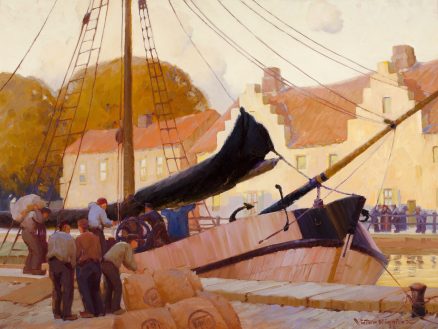- Categories
- Landscapes
- Zoom in on Artwork
- Print Page
- Email Page to Friend
Victor Higgins’s portrayal of a busy quayside scene focuses on the activity of men loading a moored vessel, its slack rigging and furled sail silhouetted against buildings fronting the canal on the opposite bank. There, more figures gather along a railing above the shimmering water. The far bank glows in the light of a low sun, while the foreground is shadowed. Such tonal contrasts dominate the composition, particularly near the center of the painting, where the black sail and bow trim of the boat are set against the brightest area of the background, the illuminated façades of the buildings. Throughout, Higgins balances complementary forms: the rope ladders descending from the mast echo the building’s stepped gables, for example, and the boat’s curving bow finds a counterpart in the rounded forms of the trees in the left distance.
This work is a product of Higgins’s visit to the medieval city of Bruges, Belgium, as evidenced by the quaint style of architecture, the wooden sabot shoes worn by some of the laborers, and the tjalk, a traditional type of snub-nosed, one-masted vessel common on the canals and coastal waters of Western Europe. During his three months in Bruges in late 1912, Hennings made numerous pencil sketches, plein-air oil sketches, and finished paintings. This rather large canvas was probably among the more ambitious works the young artist brought home to Chicago after more than two years abroad. It may well have been one of the thirty-five paintings included in his solo exhibition at the Palette and Chisel Club in May 1913, only weeks after his return. A work titled On the Quay, likely this painting, was shown the following year in the members’ annual exhibition. The reviewer for the Chicago Evening Post reported that a private collector had purchased On the Quay at St. Ives, a title that may refer to another painting or reflect a confusion of this canvas with works Higgins had executed earlier in St. Ives, Cornwall.i
Shortly after his return to Chicago, Higgins made his first trip to Taos, New Mexico, which quickly became his nearly exclusive source of artistic subjects and inspiration. Yet it was during his relatively brief time in Europe that the artist developed his distinctive style, characterized by flattened, contained forms; decorative brushwork; and a powerful, almost sculptural compositional aesthetic—all evident in this early painting.
Wendy Greenhouse, PhD
Donated by M. Christine Schwartz to the Harwood Museum of Art, Taos, New Mexico, in 2023
i Lena M. McCauley, “Art and Artists,” Chicago Evening Post, Apr. 18, 1914.
